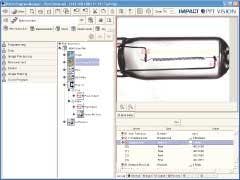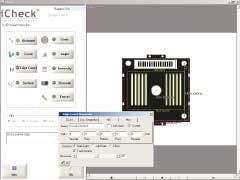Intelligent cameras embed new low-cost functions
Vendors are tailoring their smart cameras to meet a range of applications with embedded sensors, processors, and networking capabilities.
By Andrew Wilson, Editor
Driven by higher levels of integration and reduced costs of sensors, processors, and peripheral devices, smart or intelligent cameras offer systems developers an alternative to complete machine-vision systems. These cameras lower the cost of integration and relieve the design burden of choosing individual cameras, frame grabbers, and software. Although this is proving cost-effective in some applications, it may be less useful when developers require open, easily programmable, machine-vision or image-processing hardware.
In the past year, the number of camera manufacturers and products has increased dramatically, with new camera designs addressing the security, military, semiconductor, and machine-vision markets. Broadcast-standard analog cameras still dominate the low-cost security markets, but FireWire, USB 2.0, Camera Link, and Gigabit Ethernet sensors have come to dominate machine-vision applications. In the design of such cameras, vendors have incorporated the latest CCD or CMOS devices, analog front ends (AFEs), and off-the-shelf interfaces to produce low-cost products.
CAMERA DESIGNS
Kodak Image Sensor Solutions (Rochester, NY, USA; www.kodak.com) is now introducing a reference design for the company's KAI-0340 interline CCD. The Camera Link design uses a serial interface to allow commands to be sent from an external PC over the Camera Link interface to directly program the operation of the image sensor (see "Camera design targets vision and security," p. 14). In the development of its latest 1394a-compatible camera, Imaging Solutions Group (ISG; Fairport, NY, USA; www.isgchips.com) used the SLIS-2048, a 2k × 1 sensor from Panavision SVI (Homer, NJ, USA; www.panavisionsvi.com) with an on-board field-programmable gate array (FPGA), for developing custom algorithms (see Fig. 1 and "FireWire cameras tackle linescan applications," p. 9).
Because these camera designs use microcontrollers and FPGAs, they are limited in the machine-vision functions they perform. While the Kodak reference design uses an 8-bit microcontroller to program the sensor, for example, it has no on-board image-processing capability. By using on-board FPGAs and lookup tables, as is common in most of today's machine-vision cameras, vendors can offer limited on-board image-processing functions such as thresholding.
One of the main reasons for the lack of on-board processing capability is the data rates imposed by the sensors themselves. With linear arrays of 2k x 1 running at data rates of 40 MHz and greater and area arrays of 1024 x 1024 pixels clocked at 30 frames/s now common, the task of performing sophisticated image-processing techniques is often off-loaded to the host processor. To achieve this, machine-vision systems must DMA data from the camera to inexpensive host memory where it can be processed by fast CPUs running in excess of 3 GHz.
Therefore, many camera vendors are reluctant to commit their engineering departments to building smart cameras that incorporate image sensors, AFEs, microprocessors, FPGAs, and standard interfaces. Such products, they argue, will not hold their value since the price/performance ratio of microprocessors, memory, display controllers, and Ethernet interfaces is continually decreasing. Better value may be obtained from developing lower-cost cameras by incorporating the latest CCD or CMOS imagers with FPGAs, front ends, and interfaces, while leveraging the base of established PC-based machine-vision software.
LEVERAGING SOFTWARE
While this argument holds true for many camera vendors, a number of companies have introduced products that do indeed incorporate all the aspects of a smart camera (see table). Many of these cameras incorporate the functionality of a complete machine-vision system—camera, frame grabber, host processor, digital I/O, and networking capability—into a single unit. Because of this, the systems integrator is relieved of the burden of choosing OEM components and can concentrate on his or her application. These units, however, are generally more costly than cameras designed to operate with PC-based systems.
Realizing this, smart-camera vendors are leveraging their products with ready-to-use machine-vision software. Recently, both Matrox and PPT Vision introduced smart cameras that leverage both companies' existing software. The Matrox Iris P Series features an Intel processor running Windows CE .NET and can be programmed using the Matrox Imaging Library; the PPT Vision Impact T10 Intelligent Camera is designed to use the company's Inspection Builder software (see Fig. 2 andVision Systems Design, July 2004, p. 47).
Many companies now offering smart cameras have used the same philosophy. In the design of its In-Sight family, for example, Cognex has incorporated its In-Sight Vision spreadsheet to enable the selection of tools and parameters from drop-down menus and automatic insertion of tool results into cells. These can then be linked together to perform the desired task. Like Cognex, DVT also offers graphical-user-interface-based software to manage its range of image sensors. The free software package, FrameWork, is a Windows-based program that includes OCR, ObjectFind, and Scripting.
TARGETING MARKETS
While smart-camera vendors such as Cognex and DVT are targeting many aspects of machine vision, they are also focusing their efforts on large market segments where single specific tasks have to be performed. For example, ipd, a division of Coreco Imaging, currently offers three products targeted at specific machine-vision applications. The company offers three "vision appliances" that include iCheck, for product assembly and verification applications, iGauge, for precise measuring and inspection applications, and iLabel, for label placement and quality verification. In all three products, an intuitive interface allows developers to initiate and create custom inspections.
Using iCheck, for example, tasks such as presence/absence, feature counting, feature verification, measuring, surface checking, and barcode reading can be configured using the products user interface (see Fig. 3). Because such markets as barcode reading and verification are relatively large, a number of companies have developed products especially to meet such applications.
Smart cameras can meet the demand of both application-specific and programmable machine-vision tasks. In choosing a specific camera type, developers should carefully consider their applications. For relatively simple inspection applications, a low-cost embedded sensor may be the best choice. In systems where the camera has to be configured to meet several tasks, the developer may do better using a more programmable system that offers a complete software-development package.
DownloadSmart Cameras Integrate Machine-Vision Capability table. {pdf size: 92KB}



